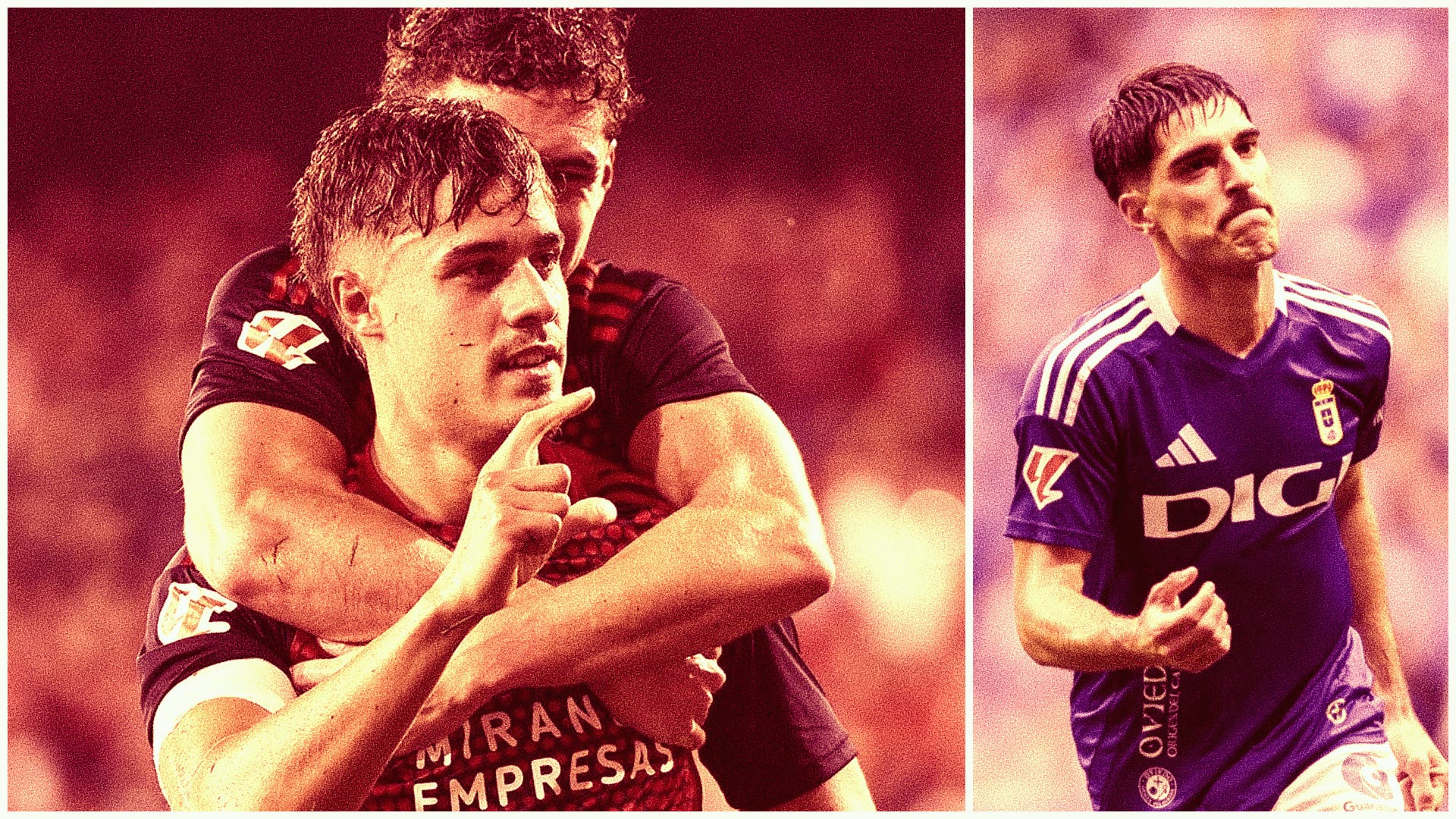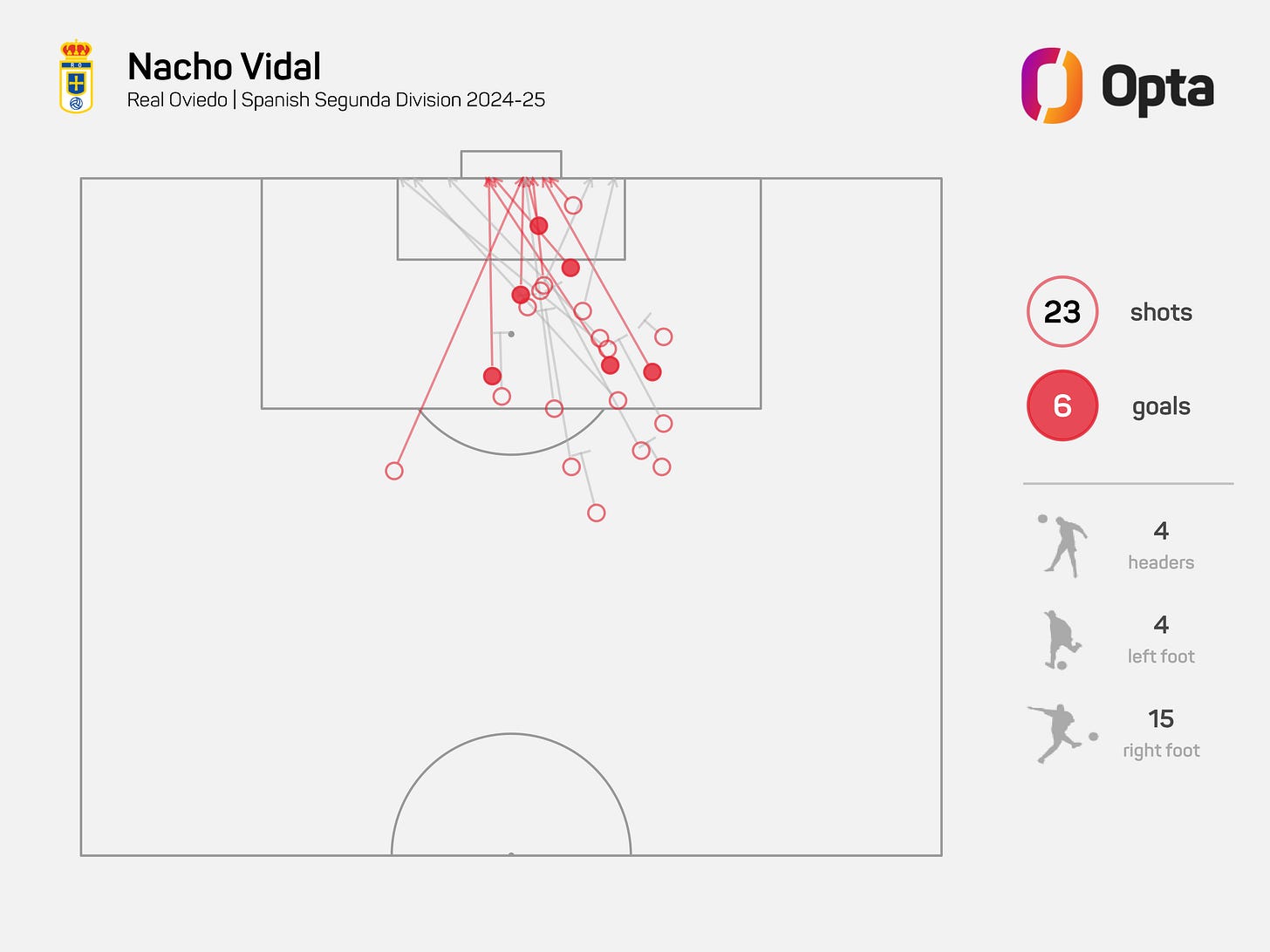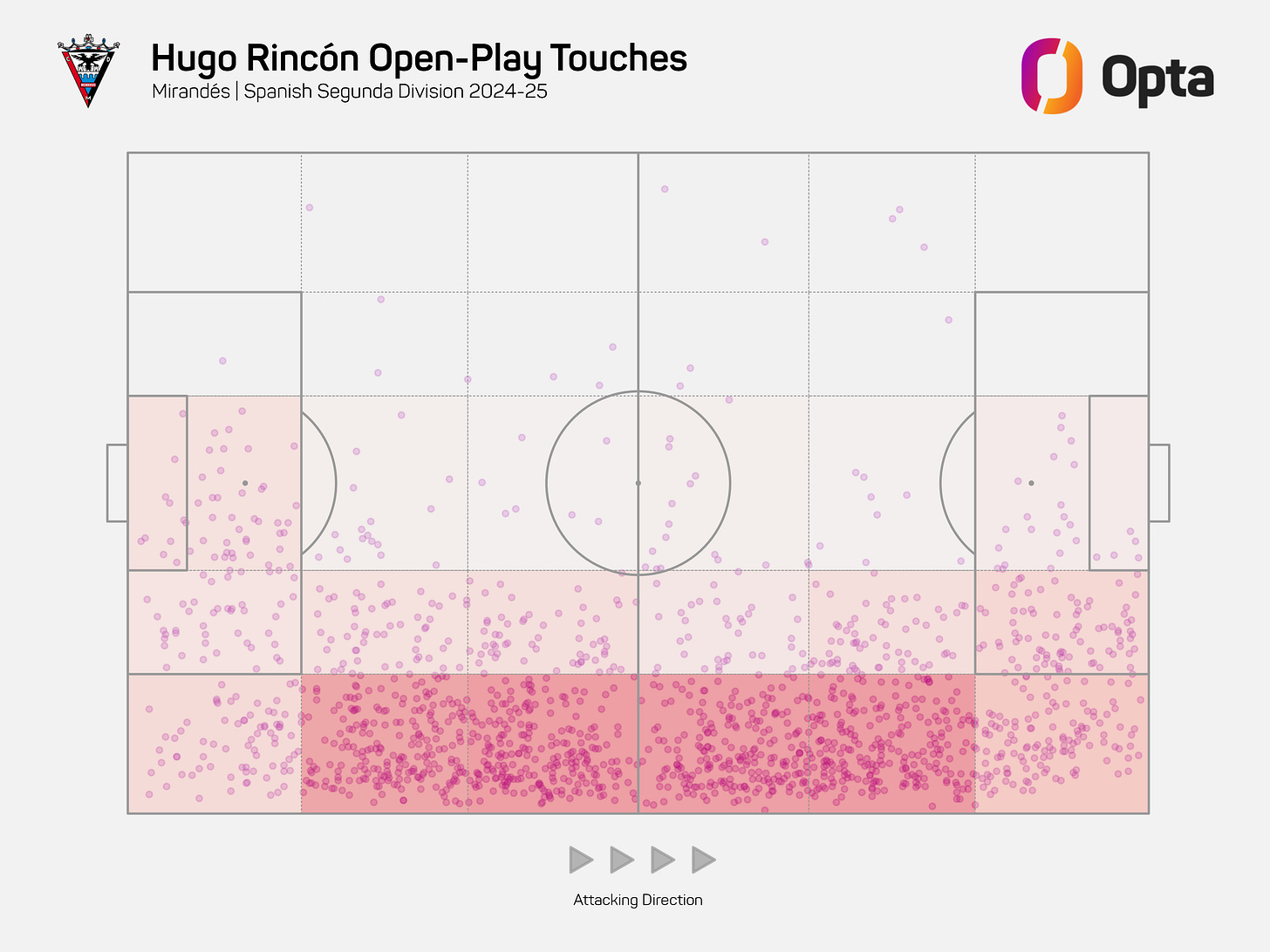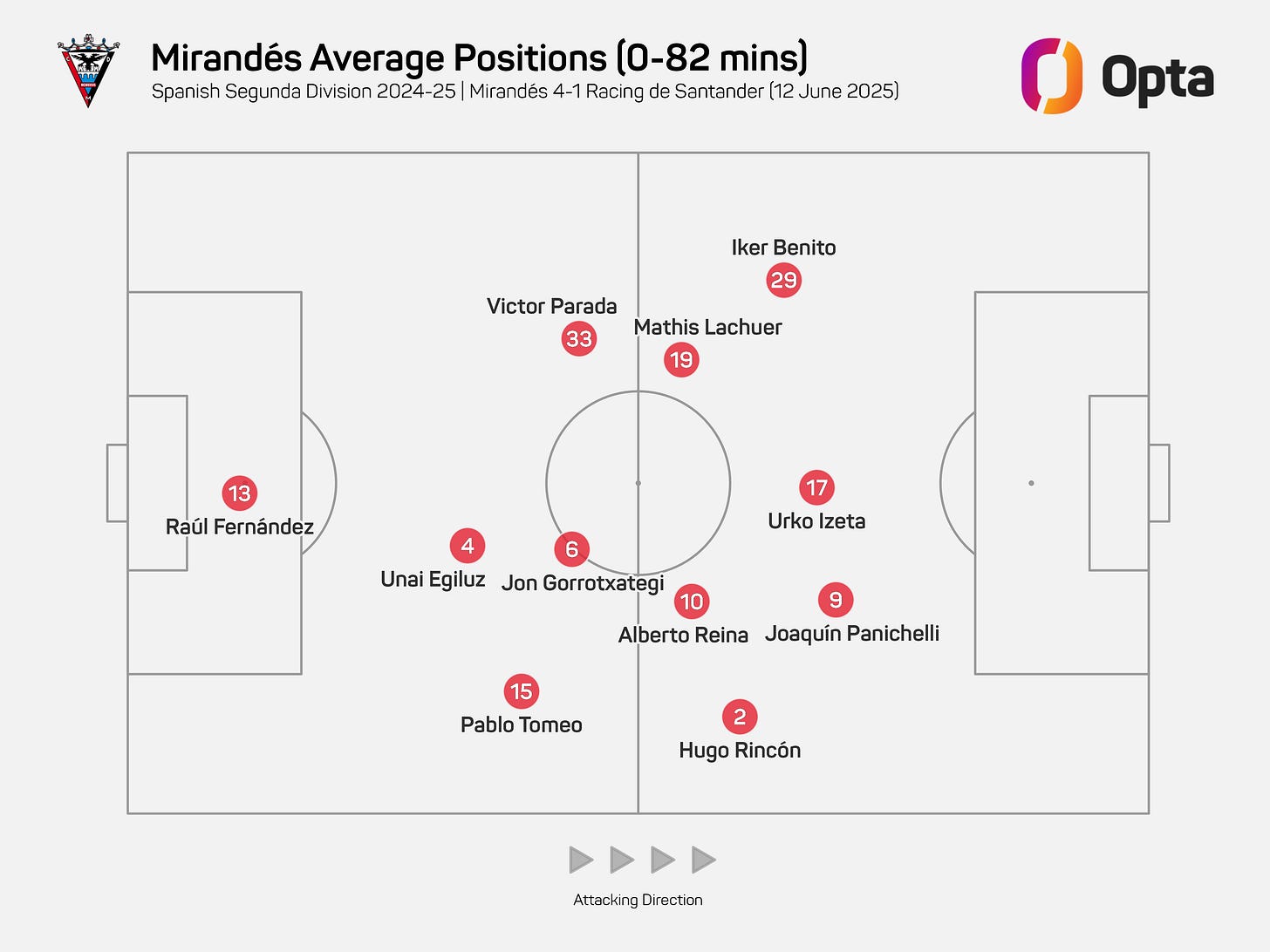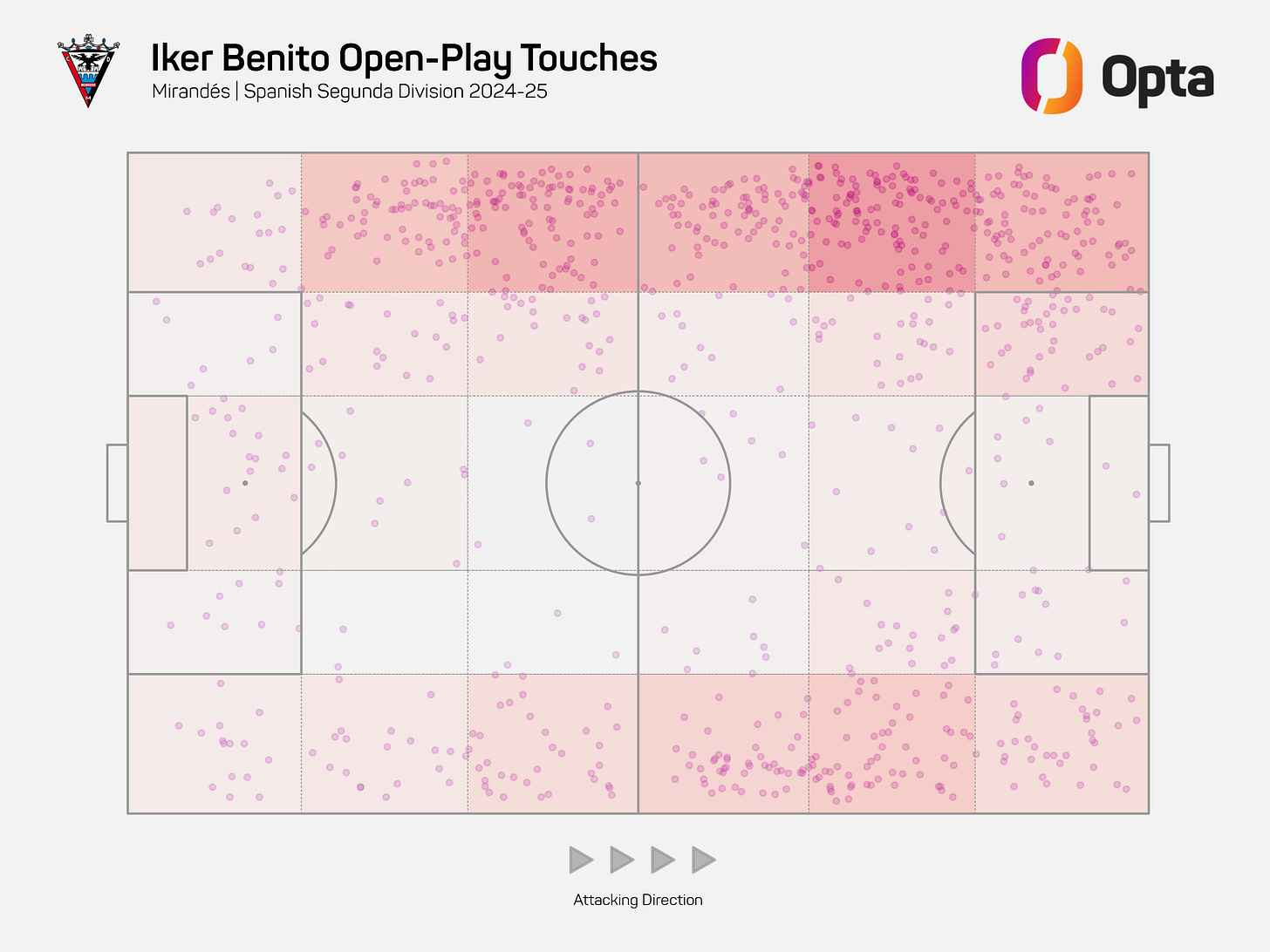The wing back flyers who could decide LaLiga’s final spot
Real Oviedo and Mirandés have plenty to thank their full backs and wing backs for in their respective runs to the play-off final.
The play-offs in Spain’s second tier are the cherry on top of a parity cake. Coming at the end of a 42-game regular season of excruciating margins, with half of the league fighting for promotion and where just about anyone can beat anyone, the play-offs compact it all into six games where four of those good enough to still be standing throw every resource they’ve got at the other and hope it’s enough to squeeze them over the line.
In that context of fine – and then ever finer – margins, precisely where to find your advantages as a team is at the forefront of coaching minds. This year, it has been the full backs and wing backs who’ve come to the fore in a major way, exerting a decisive influence across almost all of the play-off action, as well as in the defining months of the league campaign.
The first match of this post-season saw a right back score twice in a 2-1 win for Real Oviedo. A day later, another right-sided defender would score a stunning solo goal to put Mirandés in 2-0 command in the other semi-final tie, before adding another key assist in the second leg (and forcing another goal later on). By the end of the four semi-final games, the two players who had been involved in the most shot-ending sequences of play were the two wing backs of Mirandés, while two of Oviedo’s three play-off goals had been scored by a full back.
While the functions of these players varies greatly, along with their attributes, a repeated theme of the post-season has been their ability to create an extra man in attack. Late arrivals at the back post have frequently caught opposition full backs out, exploiting their natural propensity to tuck in. And with pressing from the front generally dialled down, players on the sides have been adventurous in their movement in trying to unpick defensive shapes, throwing in runs through the middle along with stretching the play.
Whether it’s through pure speed on the flanks, surprise runs on the inside of centre back and full back, dummy runs made only to confuse match-ups, or isolating players one-v-one in wide areas, the full backs and wing backs of the play-off final have been finding their way into the danger zones a lot. Even if you know what to prepare for — as both of these sides will — the variability of those contributions have already shown us how tough they can be to stop on the fly.
Whichever way the play-off final ultimately falls, expect those on the flanks to have a major say. And if you’re involved, just pray the difference between winning and losing isn’t one of your wide midfielders losing sight of a sneaky run.
Nacho Vidal (30) — RB, Real Oviedo
Since making his debut for Real Oviedo in January, Nacho Vidal has scored more goals than any other player for the team… from right back. In fact, his six strikes are more than the team’s two main centre forwards – Alemão and Fede Viñas – have managed between them in the same period (5).
Long time followers of Spanish football will find that strange for many reasons. Not least for the fact that Vidal has never been known as a goal threat, or even an overly offensive full back. Before scoring six goals in his last 17 games for Oviedo, the 30-year-old had scored two goals in 187 league appearances within the top two tiers of Spanish football. It’d be fair to say the Asturian club definitely didn’t sign him on the strength of his goal record, nor could they have expected the touch he was about to find.
In reality, the equation is pretty simple. Players who score a notable number of goals in football aren’t those who just finish better than the rest, but rather those who get into notable scoring positions and do it more often. That’s just what Nacho Vidal has begun to do, with a big helping hand from Veljko Paunović’s pizarra.
Though they’re known for their watertight defence, Oviedo are more aggressive in possession than they probably get credit for. Accepting the risks, they’ve not been shy with their attacking shapes or willingness to commit bodies to attack, even in the crucial moments down the stretch of the season with games in the balance. Indeed, it was Nacho Vidal himself – popping up from right back – who got the ball rolling for them almost instantly in these play-offs.
In the clip below from the first leg at Almería, we see him taking up an early high position up on the right side, reacting to midfielder Jaime Seoane dropping in between Oviedo’s two centre backs. Note how Almería’s left winger, Leo Baptistao, instantly points backwards to his teammates to be aware of Vidal’s position, though their problem pretty quickly sets in. Vidal occupies Alex Centelles, opening the wide channel for his winger, as his team are successfully able to play through the lines on the other side. And all the while, Vidal is busy prolonging his movements into a CF position, before eventually tapping home the parried shot.
By this point, it’ll be no surprise for opponents to see Nacho Vidal taking up advanced positions – be it stretching the play wide or in higher central areas. The problem is that within the dynamic flow of the game, it’s hard to always keep track of matchups and players entering zones that are atypical from their standard position. As we saw with their opener at Almeria, even the slightest disconnection between full back and winger on the opponent’s part can quickly develop an uncomfortable progression of attack.
Oviedo and Vidal are well aware of that. Here is in the second leg of the same tie, making another unadvertised run into a high central area and provoking momentary confusion for his opposition.
Vidal, who’s the most experienced of the final four, is the least ‘explosive’ in his arrivals into the danger zone, but almost certainly the most intelligent in the positions he takes up from his right back starting position.
Though he’s netted a prolific six times for Oviedo since February, his drifts into central areas could be equally crucial even if only to isolate Haissem Hassan on the flank; one of the league’s most dangerous one-v-one practitioners.
Rahim Alhassane (23) — LB, Real Oviedo
If Nacho Vidal is Oviedo’s roaming right back, the guy who takes up creative positions, mixes up markers, and spooks teams with his crafty arrivals in the box, then Rahim Alhassane is a much easier read for the opposition. That doesn’t mean he’s any easier to stop, though.
The 23-year-old is a punishing runner from left back. His ability to repeat long, intense runs at speed throughout 90 minutes is an attribute that ticks a box in most full back or wing back profiles, but one that becomes especially valuable by this time of the season. All four managers involved in the Segunda play-offs have already spoken about the element of fatigue and how it figures into their game plans and team selections at this crucial stage. Players who can be out there for the duration without suffering notable physical declines are just play-off gold.
Safe in that knowledge, Oviedo and Paunovic ask a lot from him in attack. Regardless of who plays on the left wing ahead of him, the flank usually belongs to Alhassane in both halves of the pitch. And even when starting from a deep position he provides a huge amount of thrust for Oviedo’s play, hauling them up the pitch and giving them those waves of impetus that sustain play-off atmosphere (at least at home). Those bursts from lower starting positions are simple but highly effective.
Alhassane is also one of those full backs who need only intervene once or twice a game to really hurt you. Unlike Nacho Vidal, who’s more connected to general play and more influential in his passing, the former Recreativo man tends to appear in short, high-impact moments that leave opponents wondering where he came from. Catching markers a step slow is a permanent threat that he poses, while he’s got a reliable sense of when to take off depending on where the play is and who’s in possession.
Transitions could be another key for Oviedo in the play-off final, particularly when they can get the 23-year-old involved. Just look at the reaction to his side recovering the ball in the clip below, at a point where his side already had the result they needed to eliminate Almería and get through to the final.
Any moments where the opposition are likely to be scattered and potentially vulnerable after turnovers will usually, and quickly, see Alhassane arriving on the scene.
The flag denied Oviedo’s left back of a signature, tie-killing assist on that occasion, but he’ll be hunting his opportunities against Mirandés too. And with their extra day of rest in the tank – a fact their opponents aren’t too happy about – his late-game contributions have the potential to sting.
Hugo Rincón (22) — RWB, Mirandés (Athletic Club)
While the aforementioned Oviedo pairing are much closer to orthodox full backs (at least in the modern game), Hugo Rincón and his opposite number, Iker Benito, firmly belong to the wing back category. It’s worth making that distinction from the jump, even if these four players are likely to be sharing very similar spaces on the pitch over these two legs.
Starting with Rincón, the man on loan from Athletic has been similar to Nacho Vidal in the scale of his influence on his side. And quite frankly, there’s no shortage of candidates for Mirandés MVP this season. Rincón has been spectacular enough down the stretch of his team’s season to warrant a legitimate case, even with the goalscoring feats of Joaquín Panichelli and Urko Izeta, as well as the masterful midfield play of Jon Gorrotxategi.
As for how he differs from Vidal, the 23-year-old is much closer to a pure winger in Alessio Lisci’s 3-5-2 system than he is a full back. His characteristics are plenty different too, with Rincón providing much of his value through driving runs up the flank to arrive at the sharp end of attacks.
Much like Vidal, however, they share a similar nose for getting all the way into the box and finding scoring opportunities — and usually just on time, at the very last moment.
Rincón has been directly involved in three goals in his last four Segunda games, scoring twice and assisting their opener in the semi-final second leg. Indeed, he was close to both assisting and scoring in that 4-1 win over Racing Club, with his powerful strike (that may have just been going wide) being deflected in by Javi Castro, after a signature arrival at the back post.
For Oviedo, the threat Rincón poses is that he can get beyond the last line in a variety of ways. Whether it’s with his ball carrying, as we saw in his lung-busting run and finish in the semi-final first leg at El Sardinero, or making runs without the ball, Mirandés have been able to get their right wing back into threatening positions with plenty of joy at the business end of this season.
The scale of his contribution on the right side has been huge for Mirandés, typically resembling a full back, wing back and winger all within the same game. That variability tends to cause doubt on the part of the opposition too, with Rincón being part the responsibility of the opposite full back and part for the winger ahead of him. He often takes up positions in between where he’s stretching the play enough to be considered an attacker, but without the opponent’s wide player being concerned enough to begin to worry about his positioning.
When that happens, it puts Rincón in prime position to accelerate out of blind spots and get the run on any attention from the opposition. Throw in the fact that Alberto Reina — Mirandés’s right-sided midfielder/forward combo — can often attract the attention of the opposition’s left back and you have a nice opportunity to be able to find Rincón attacking advantageous speed at pace.
Speaking after the game in midweek, Racing Club manager José Alberto noted that his side had prepared specifically to combat that threat from Rincón, but were still ultimately unsuccessful in stopping him – most notably in the opener on the night. “It was a goal we had worked on a lot, something we’d worked on precisely during these [last] four days and we ended up conceding again,” he told reporters.
Facing Mirandés entails a lot of things, but wing play is a huge strength of theirs and something they’ve worked at all season. In this case, it was a perfectly timed third man run from Rincón that took the lid off Racing’s defence, following some split-second misjudgements from Marco Sangalli and Mario García in how they were covering the flank (and a terrific pass from Alberto Reina to thread the needle).
Regardless of who gets the nod to start on the left wing for Oviedo in the final, it wouldn’t be a surprise to see Paunovic opt for a temporary defensive line of five players when out of possession, sending his winger back all the way. In that case, it’s more likely to be their left-sided player given Rincón’s prominence in recent games, as well as the fact that right winger Haissem Hassan is one of Oviedo’s weaker defensive players.
The Asturian side suffered early on in the semi-final second leg with Almería committing five to their forward line and recruiting wing backs on both sides, before adjusting to match those players up more closely. Against a Mirandés side who regularly drive similar numbers up into the final third, Paunovic will surely consider doing so from minute one here.
Iker Benito (22) — LWB, Mirandés (Osasuna)
22% of the non-penalty goals scored by Mirandés this season have been finishes from crosses (13/59), while they also rank first among all Segunda teams this term for open play cross accuracy (27%). They’re not shy in getting the ball into the area, they’ve got high quality players to attack deliveries, and most crucially from Alessio Lisci’s perspective, they work good positions to do so. Their league-leading efficiency is testament to that.
In that regard, their main contributor is Iker Benito; the other half of the Mirandés wide attack. Where Hugo Rincón is the natural full back who’s been turned into the flying wing back, Benito has come from the opposite direction as an orthodox wide player to seize the left-sided responsibility in the team.
Although their heat maps might look similar on any given day, what Mirandés hope to achieve when finding Benito contrats with what they do when connecting with Rincón. Of the many, many considerations that go into re-positioning the 22-year-old as a wing back in the system – plenty of which have nothing to do with attacking or dribbling – Alessio Lisci knows that, at heart, the man on the left is still a winger in his instincts. Within what Mirandés aim to achieve, there’s room for Benito to attack as if he would having started as a winger in a 4-3-3, and that variety is an essential part of their play — especially in the play-offs.
Where attacks through Rincón tend to be dynamic and flowing, featuring him as one of many moving parts, passses and switches out to Benito on the left hand side are often a time for Mirandés to pause and let him go to work.
The Osasuna man is one of the few players that Mirandés — a team who don’t rely on dribbling — can count on to give them some juice in isolated moments. Even the teams who are productive without dribblers still need something from somewhere, especially in the play-offs when things get tight and opponents shell up behind the ball.
Along with natural winger speed, Benito is a tricky read for defenders for the fact he can take them both ways when getting into one-v-one scenarios. His involvement when receiving in the final third is usually comprised of flashed balls across the box after quick dives to the byline and cuts onto his right to supply crosses on his stronger foot.
Reading which one is coming to able to stop that yard or two being created is the hard part, and Benito has regularly shown he doesn’t need to fully beat his marker to generate danger. Get too tight and his acceleration can create the space; stand off too far and he can serve up some very able Mirandés forwards.
A big part of Mirandés being the most efficienct crossers in the division is down to Benito. He’s connected with a teammate on 37% of his deliveries from open play this season; the best percentage of any player to attempt 50+ such crosses.
Though Hugo Rincón has stolen the limelight for Mirandés in recent months, and has been the much more stable option at wing back all season long, Oviedo will be equally aware of the threat coming on the opposite side in the final. With play-off football’s timeless capacity to become a grind and make chance creation a slog, Benito is the best-placed wing back involved when it comes to isolation play with no support; the guy who can go when all else has failed.



